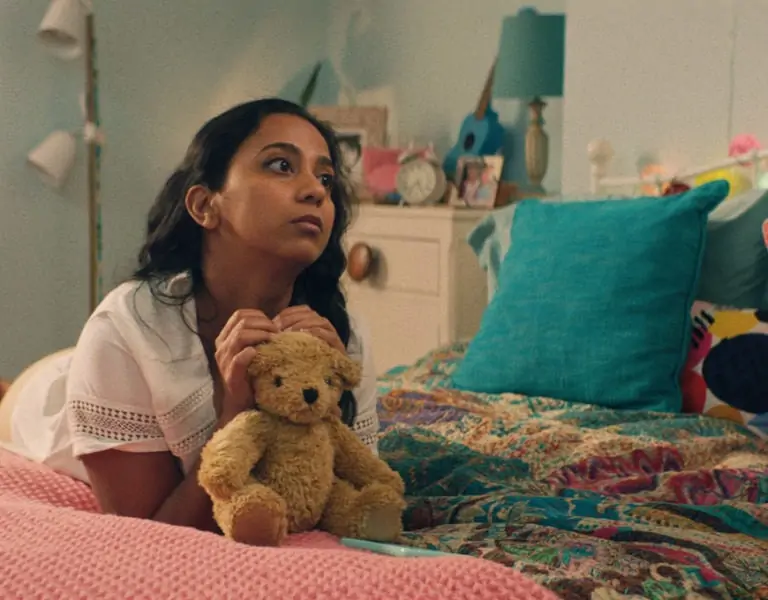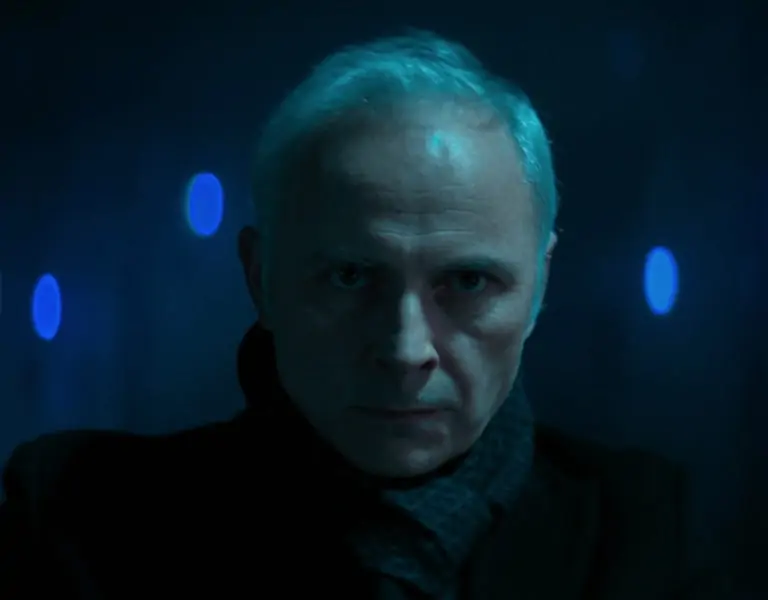FASHIONABLY BAD
Cruella serves as the origin story for an infamous and fashionable Disney villainess first introduced to moviegoers in the animated classic 101 Dalmatians in 1961. Cinematographer Nicolas Karakatsanis reveals how he lensed a production filled with colour, energy and dark humour.
Giving in to bad behaviour was just a matter of time for the title character of Cruella, portrayed by Emma Stone; however, for Belgian cinematographer Nicolas Karakatsanis (Triple 9), his true calling was discovered by accident.
After quitting film school in Brussels, he was hired by a former teacher to shoot a commercial. “He told me, ‘I can see that you have a good eye, so I’ll put a good crew around you, and you tell them what you want.’” It worked out. Lacking technical expertise, the young cinematographic talent would describe the end result he wanted to achieve. “I like to be surrounded by people who have more knowledge than me because that means I can still learn,” he says.
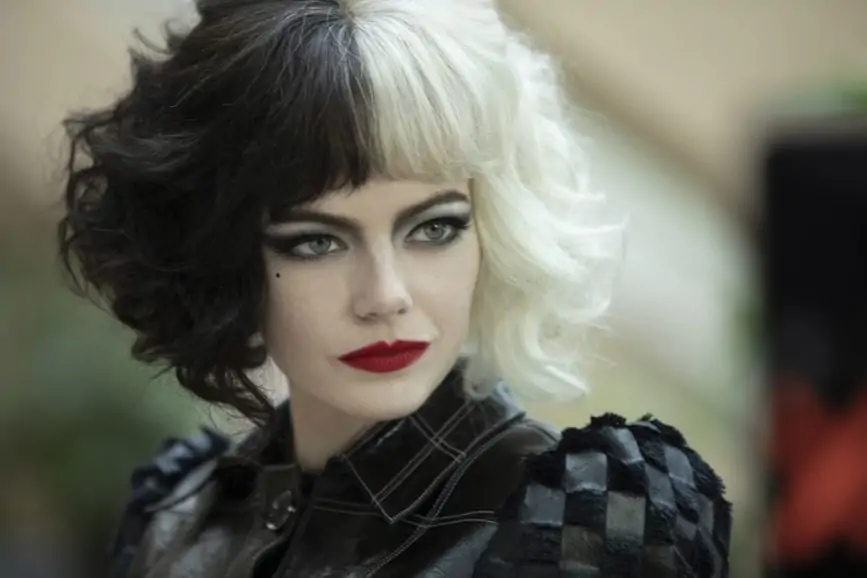
Familiar and new faces made up the crew for Cruella. “I had never worked with gaffer Chuck Finch before and it was a dream come true,” says Karakatsanis. “I also did not know key grip Patrick Garrett who worked on Game of Thrones. I’ve done a lot of commercials in the UK with 1st assistant camera Job Reineke who put together the camera crew based upon the style that I like. [Director] Craig Gillespie [Fright Night] loves to work with Steadicam, and for it to have lots of energy and forward pushes. It’s tough on the operators. The B camera operator/Steadicam operator became Jess Doxey.”
Other key members were A camera operator Pete Batten, 2nd assistant camera Lawrence Beckwith and Christina Cretu, DIT Francesco Giardiello, shadow unit DP/camera operator Stuart Graham, Austrian cameraman Florian Hatwagner aka Gimbalninja, and colourist Tom Poole at Company 3.
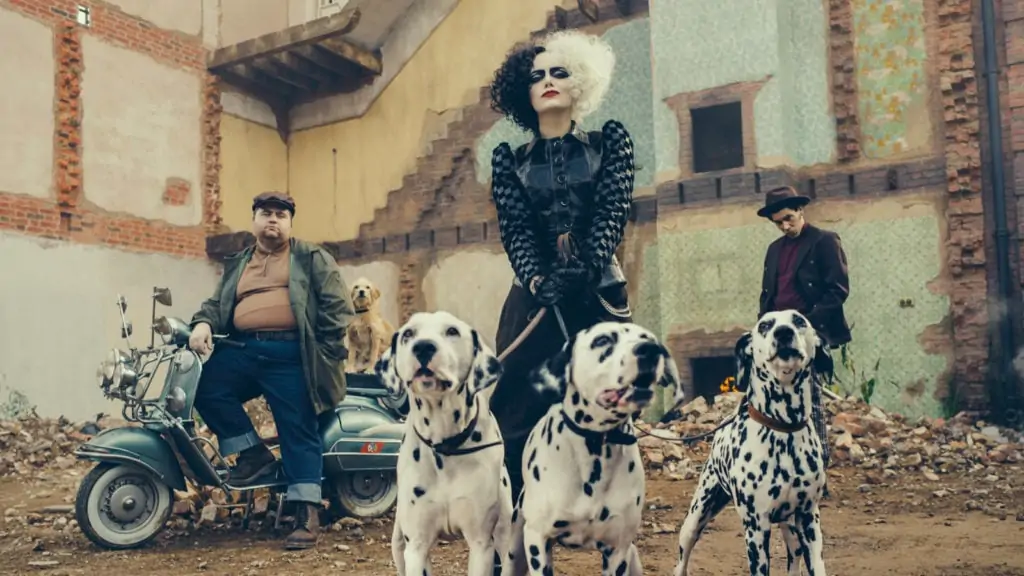
“For me, the resemblance between I, Tonya and Cruella is in the dark humour,” notes Karakatsanis. “The process was the same. We were at Craig’s place in London at the time doing the blocking of scenes. We talked about how to reorientate the script to make scenes more fluid. The implementation of sets was bigger because of the scale. You have to project yourself into a three-dimensional environment although it doesn’t exist yet. You’re thinking, ‘Did I put enough windows there? Are there enough lights on the wall? Do we have the angles needed for these scenes?’ I like to light for the room rather than for the actors because when a director wants to change everything it’s not a big deal.”
Karakatsanis had three and a half months of preproduction and 65 days of principal photography, evenly split between soundstages at Shepperton Studios and locations. “You don’t want to have locations that look like another movie and the other question is what type of actions are going to take place in that location. Disney tries to keep as much as possible onstage because it’s a lot of people and gear to move. It’s also easier to control the shooting environment with press and paparazzi.” Two pivotal moments occur at the estate of the Baroness next to a waist-high stonewall overlooking a cliff and a raging sea. “All of that was shot on location except for the cliff and sea which were CGI.”
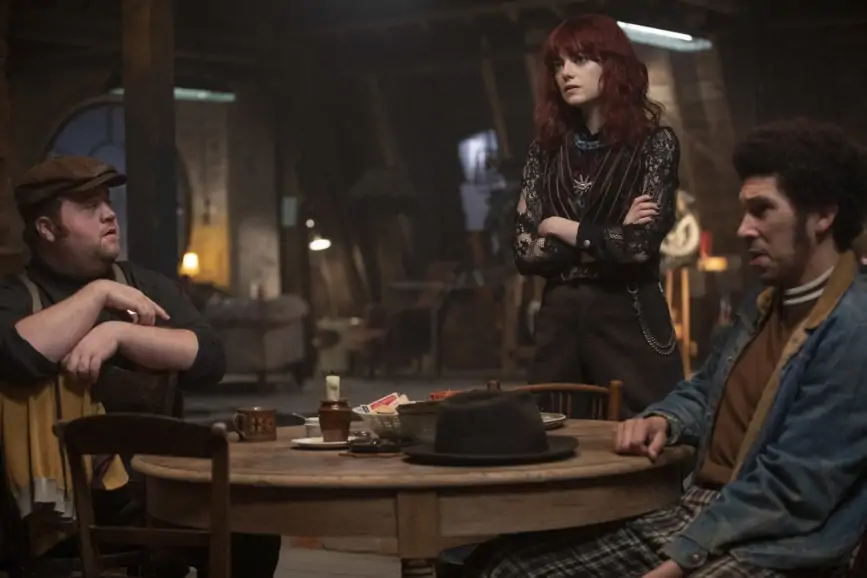
The preference for Gillespie and Karakatsanis is to capture the footage with a single camera. “The ARRI Alexa Mini was for everything Estella/Cruella, and its mostly handheld and Steadicam. The ARRI Alexa 65 was for the Baroness [Emma Thompson] with cranes, dollies, and Steadicam. We differentiated their worlds where Cruella was a bit looser and had the small sensor while the Baroness had the big sensor because everything is opulent, and the architecture is gigantic, so it was a more stern and steady photography. The idea was that Estella/Cruella is hard to control which is why we went with the handheld vibe or Steadicam. When Cruella inherits the whole world of the Baroness, she gets the ALEXA 65 too.”
It was a given that the Leica Summilux-C would be the primary lens. “I own a set and it has the best balance in terms of the bokehs, depth of field and the humanity on close-ups,” states Karakatsanis. “However, the Summilux-C does not cover the ALEXA 65 sensor. I decided to go with Leica Thalia which is rehoused Leica S still lenses. The Thalia seamlessly matched with the Simmilux-C because they have the exact same identity and characteristics. For the last eight and nine years as a DP, I’ve loved a 29mm and 40mm. These are the workhorses for everything that I do.”
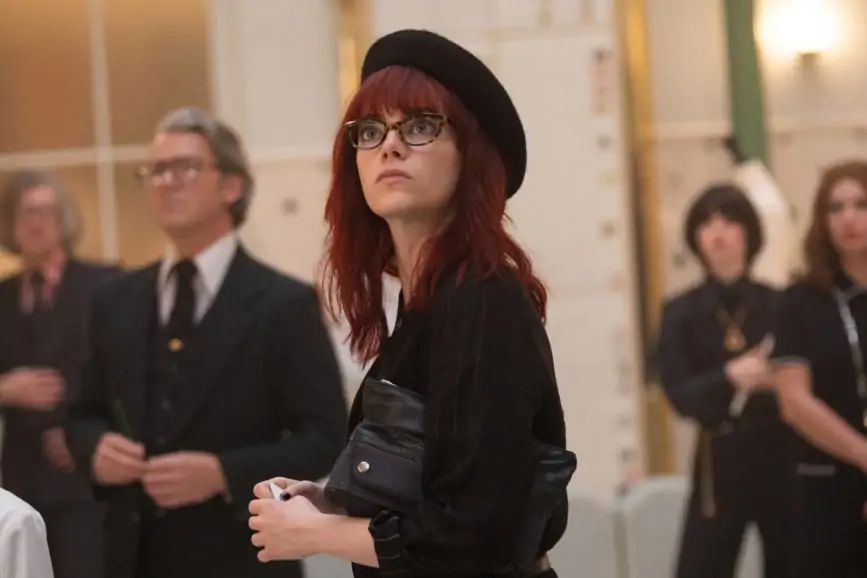
To better reflect the scope of the high ceiling architecture, the aspect ratio of 1.85:1 was chosen. “We knew that it was punk, 1970s, and London, so that was already a strong visual idea. I wanted to do everything in tungsten, especially on the faces. It was Wendy Lights, Maxi Brutes and Dino Lights. Tungsten has a richer colour density, a more natural sunlight feel, and is not too harsh on the skin of actors.”
One general LUT was created with Tom Poole which was tweaked shot by shot by DIT Francesco Giardiello. “The colour palette was embedded in the set, clothing, make-up and hair,” says Karakatsanis. “I gave Tom some graded stills and never had to say anything to him. Due to the pandemic, Craig and I had to finish the grading with Tom on calibrated iPad Pros from Company 3.”
Costumes in movies tend to be about recreating clothing from the era being depicted. “But here it is about a fashion house, so you have to invent period clothing that is original and made by a couturier. Costume designer Jenny Beavan [A Room with a View] had to make an enormous amount of clothing [277 costumes for the principal cast] within a short period.” A white hooded cape burns away to reveal Cruella in a form-fitting red dress. “That was one scene where we had previs made for timing. It was a couple of shots with the real cape and then we had Emma in the red dress, and she had pretended that the cape was still around her. Everything else was CGI.”
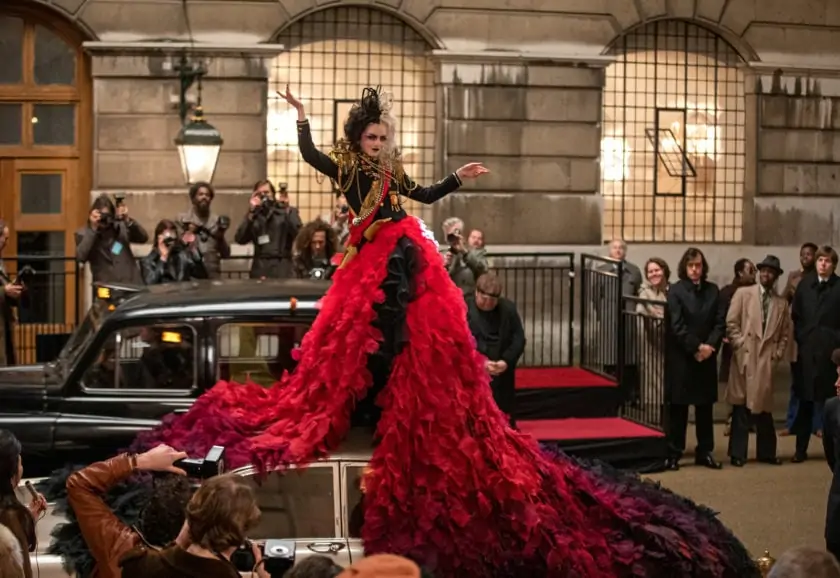
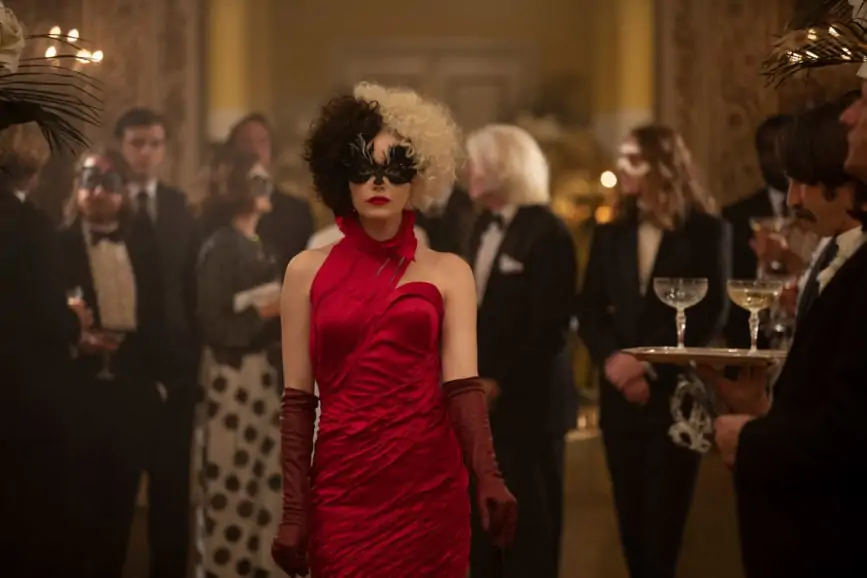
Dogs are a visual motif throughout Cruella. “Wink and Buddy were in almost every shot for real,” says Karakatsanis. “But the Dalmatians were much more complicated because we had to have them be elegant and stern.” While travelling on a double-decker bus, Estella and her fellow grifters Jasper (Joel Fry) and Horace (Paul Walter Hauser) pickpocket passengers with help from Wink. “We were talking for a long time about how to achieve that scene because it is fun to try to go with the dog down this tiny staircase. I had worked a couple of times with the Gimbalninja who combines his love for camera operating with parkour and has this compact custom-made gimbal. He was able to do the shot for real because Wink was crazy good.”
A long continuous tracking shot goes from the city street into the Liberty, London department store and down into the office area where Estella is cleaning the washrooms. “The prepping of that shot was complicated because we had to match lenses and heights, and also with the interior build that we had of Liberty onstage,” says Karakatsanis. “It’s a top shot with an ARRI Alexa Mini LF with a drone going overhead of the real Liberty store and it stops. Visual effects did the through the glass element. Once it goes through the glass it’s actually the ARRI Alexa 65 on a wirecam system that does a whole movement around people onstage. When we’re at the floor level there is a natural wipe of a person passing and the ARRI Alexa 65 is placed on a Steadicam. The moment we go through the door, it becomes the Gimbalninja because the basement of that London location was too tiny for a Steadicam.”
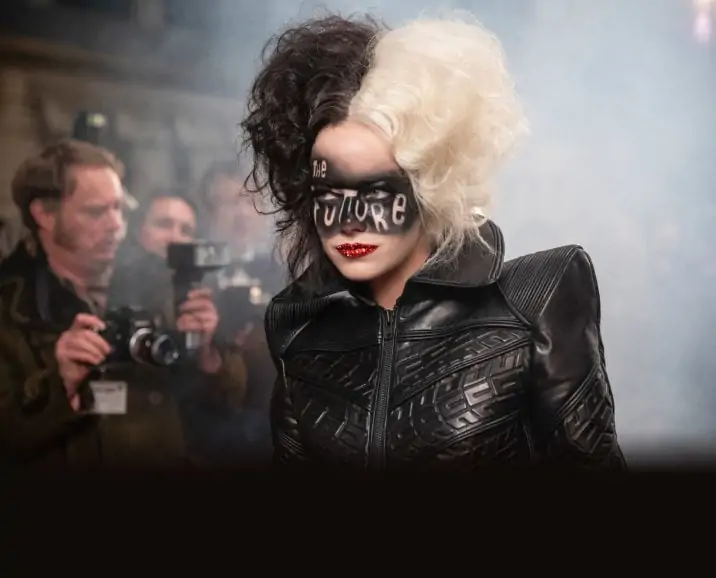
Serving as an in-camera transition from the adolescent to adult Estella is a bathroom mirror. “I told Craig that the thing I liked about the script was the duality between Cruella and Estella as well as Estella against her fake and real mom,” says Karakatsanis. “I said it would be fun to play with mirrors. That shot was done during the shot listing.” A life-altering decision occurs at a fountain where Estella finally gives in to being Cruella. “Because that scene is a big reveal to herself, I was operating the camera handheld to give it a raw feeling. We decided to do it as an oner. It was a bit weird for a Disney movie to have an indie arthouse film approach for that scene, but it was more human, interesting, organic and felt more connected to her character at that moment. I thought it was cool.”


